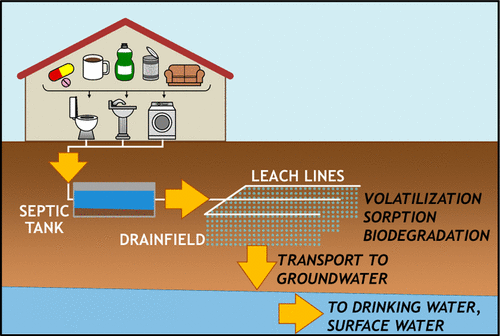Onsite septic tank systems treat wastes in by allowing solids to settle in a holding tank. The solids at the tank bottom begin to decompose into soluble organic acids and in large tanks may actually produce some methane. However, most decomposition results in organic acids which re-enter the water phase and leave the tank. Septic tanks do not remove problem criteria pollutants such as ammonia, phosphate, or enteric microbes. However, they do remove a substantial portion of wastewater BOD5 (varies with tank size and loading). After treatment in the septic tank, water flows through field lines where water slowly percolates through soil. Bacteria and fungi located in the soil particles utilize organics in the water and continue decomposition of pollutants. Soil also acts by adsorbing some of the more recalcitrant compounds where degradation occurs over longer time frames.
The study above looks at common organic wastewater pollutants (in the study termed OWCs). The results show that the septic tank itself does not remove a significant portion of many OWCs. This is a combination of recalcitrance to anaerobic decomposition, residence time, or the presence of easier to degrade compounds with limited biomass. The data from drain field effluent when compared to activated sludge treated wastewater was very interesting. For most compounds, removal rates across the drain field were very similar to that in activated sludge. The drain fields did have much more variation which can be explained by differences in drain field soils, flows, loadings, and maintenance conditions.
Overall, I see that traditional septic tanks with drain fields can be an effective treatment option for on-site wastewater treatment. Treatment efficiency depends upon proper construction, site surveys, and maintenance of the system. These systems require periodic septic tank pumping to remove inorganic and recalcitrant organic solids. The field should be checked for percolation rates and maintained as needed. What about septic tank additives? I have seen systems with problems related to fatty acids blinding the field lines (leach lines) being remediated via microbial addition. Additives can also help lengthen the life-span of the drain field by assisting in complete mineralization of complex organics, FOG, and other pollutants. However, additives will not overcome problems with an improper system design or highly fouled older system that requires installation of new leach lines.


 RSS Feed
RSS Feed